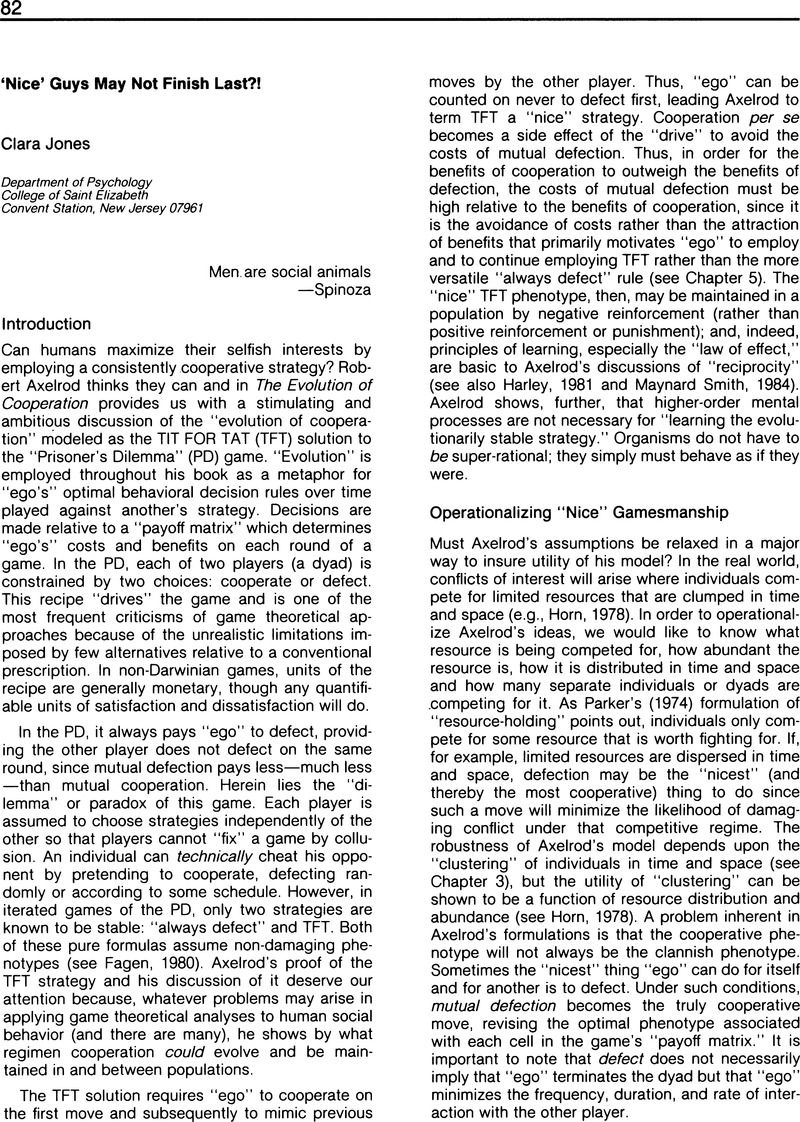No CrossRef data available.
Article contents
‘Nice’ Guys May Not Finish Last?!
Published online by Cambridge University Press: 17 May 2016
Abstract
An abstract is not available for this content so a preview has been provided. Please use the Get access link above for information on how to access this content.

- Type
- Book Reviews
- Information
- Copyright
- Copyright © Association for Politics and the Life Sciences
References
Brown, J. L. (1964). “The Evolution of Diversity in Avian Territorial Systems.” Wilson Bull 76: 160–169.Google Scholar
Brown, J. L. (1974). “Alternate Routes to Sociality in Jays—With a Theory for the Evolution of Altruism and Communal Breeding.” American Zoologist 14: 63–80.CrossRefGoogle Scholar
Chase, I. D. (1980). “Cooperative and Non-cooperative Behavior in Animals.” American Nation 115: 827–857.CrossRefGoogle Scholar
Dawkins, R., and Krebs, J. R. (1978). “Animal Signals: Information or Manipulation?” In Krebs, J. R. and Davies, N. B. (eds.), Behavioural Ecology. Sunderland, Mass.: Sinauer.Google Scholar
Ekman, P., Levenson, R. W., and Friesen, W. V. (1983). “Autonomic Nervous System Activity Distinguishes Among Emotions.” Science 221: 1208–1210.CrossRefGoogle ScholarPubMed
Fagen, R. M. (1980). “When Doves Conspire: Evolution of Nondamaging Fighting Tactics in a Non-random-Encounter Animal Conflict Model.” American Nation 115: 858–869.Google Scholar
Harley, C. B. (1981). “Learning the Evolutionarily Stable Strategy.” Journal of Theoretical Biology 89: 611–633.Google Scholar
Horn, H. S. (1978). “ptimal Tactics of Reproduction and Life-History.” In Krebs, J. R. and Davies, N. B. (eds.), Behavioural Ecology. Sunderland, Mass.: Sinauer.Google Scholar
Jones, C. B. (1983). “Social Organization of Captive Black Howler Monkeys (Alouatta caraya): ‘Social Competition’ and the Use of Non-Damaging Behavior.” Primates 24: 25–39.Google Scholar
Maynard Smith, J. (1974). “The Theory of Games and the Evolution of Animal Conflicts.” Journal Theor. Biol. 41: 209–221.CrossRefGoogle Scholar
Maynard Smith, J. (1984). “Game Theory and the Evolution of Behaviour.” The Behavioral and Brain Sciences 7: 95–125.Google Scholar
Parker, G. A. (1974). “Assessment Strategy and the Evolution of Fighting Behaviour.” Journal Theor. Biol. 47: 223–243.CrossRefGoogle ScholarPubMed
Popp, J. L., and DeVore, I. (1979). “Aggressive Competition and Social Dominance Theory: Synopsis.” In Hamburg, D. A. and McCown, E. R. (eds.), The Great Apes. Reading, Mass.: Benjamin-Cummings.Google Scholar
Tinbergen, N. (1952). “Derived Activities: Their Causation, Biological Significance, Origin and Emancipation During Evolution.” Q. Rev. Biol. 27: 1–32.CrossRefGoogle ScholarPubMed
West-Eberhard, M. J. (1979). “Sexual Selection, Social Competition and Evolution.” Proceedings of the American Philosophical Society 123: 222–234.Google Scholar


